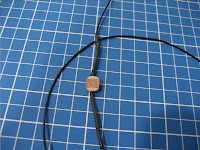Series Prototyping

* A box as the sidewalk.
* The size is similar to the first prototype.
* 3 boxes for 3 prototypes.
* 1 of 3 - 180 degree Rotation
- How it works : As a pedestrian steps on it, it will slowly turn (180 degree) and pedestrian will arrive back to his original position.
* Pieces of circles as the rotating board.
* Top/outside view, a hole to hold the pivot.
* Inside view.
* A toothpick as the pivot.
* Pieces of circles (material: art card) are stacked together to create a stronger board.
* Pivot is glued at the base and masking-taped.
* 180 degree rotation prototype.
* 2 of 3 - Light (Flame of Life)
- How it works: As a pedestrian moves/walks toward the edge of the road, light gets dimmer.
* Materials.
* LEDs.
* Bright light, placed in the beginning of the path.
* Low resistance resitor.
* Dimmer light, placed in the middle of the path.
* 2 low resistance resistors.
* Dim light, placed in the middle of the path.
* 2 lower resistance (than the before) resistors.
* The fourth LED is just as an LED with no power supply, placed at the edge of the road, end of the path.
* Connection of the lights.
* Soft switch learned in Wearable Technologies class.
* A carpet where the pedestrians walk through.
* Triggers light.
* In the making of the switch.
* The fourth row has no use.
* Conducive fabric sewn on the cloth.
* Connecting the cable to the cloth.
* Light holders.
* 4 big holes to hold the light holders
* 3 small holes to insert the cables.
* Cables from the cloth are inserted into the small holes.
* Outside and inside view.
* Light holders are inserted in the big holes.
* Outside and inside view.
* LEDs are inserted into their holders.
* One cable goes to the board, the other is attached to another piece of cloth with conductive material sewn on it (top cloth).
* Outside and inside view.
* Cable extension.
*Inside view.
* After connecting.
* Top and bottom.
* Outside and inside.
* Light - Flame of Life Prototype.
* 3 of 3 - Sticky Floor
* A hole on top of the box to place the flipping floor.
* Holders of the flipping floor.
* Holders are attached to the box (Inside).
* Flipping floor.
* Sticky floor, using double-sided tape to simulate the sticking part.
* Sticky flipping floor attached on the box.
* Sticky floor prototype.
* Others
* Traffic lights stands, 6 pieces to make each stand.
* Traffic lights.
* Prototype of 180 degree rotation.
* Prototype of sticky floor.
* Prototype of conveyor belt (previous/1st prototype).
* Prototype of Light (Flame of Life).
* Light is lighted up, if a pedestrian steps on the carpet.
* The prototypes.














































































